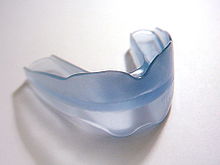Splint activator
The splint activator according to Soulet-Besombes is a removable orthodontic device for correcting misaligned teeth and jaws. It is a stylized activator (functional orthodontic device) that is mass-produced in various unit sizes. Other names include a. Position trainer and chewing force jaw shaper (K3F).
Structure and functionality
The device is made of flexible material and is made in one piece. In the middle there is a level cut in a row of teeth, which is clad by ramp-shaped walls. The rows of teeth in the upper and lower jaw bite into the gaps accordingly. However, no compartments are normally provided for each tooth; an exception here is the Australian further development Myobrace .
The device lies passively between the upper and lower jaw and does not exert any force on the teeth by itself . If the patient bites together, the out of line teeth hit the ramp-shaped walls and are moved into the intended position over time according to the principle of the inclined plane and through the deformation of the device. The patient himself determines the force that acts through the strength of his bite.
While wearing, the lower jaw is placed in angle class 1 position to the upper jaw . This should firstly allow the jaw muscles to get used to this posture and secondly the patient should learn the correct swallowing pattern . The teeth that do not reach the level specified by the device in this position are given the opportunity to grow out like a bite plate .
Special models for the treatment of undershot or undershot positions differ from the standard version mainly in the shape of the dental arch and reinforced or extended walls.
The device must be worn at night and for at least one hour a day. Bite exercises should be performed during this hour. The device does not allow you to speak , so in order to wear the device you must be able to breathe through your nose. It can fall out of your mouth at night for the first few days.
Wearing it must not cause pressure points, as these can lead to permanent tissue damage. If necessary, material has to be removed from the device.
history
In the early 1950s, the French orthodontists Prof. René Soulet and Prof. André Besombes removed the fixed braces from their patients for the duration of the summer holidays and replaced them with rubber retainers in order to stabilize the treatment results until the fixed appliance was reinserted. To her surprise, the position of the teeth and jaws had not only not deteriorated, it had actually improved. In the following they developed the construction further and called it conformateur .
distribution
The splint activator is more of an exotic among treatment devices. Recently , however, the Trainer for Kids (T4K) from the Australian company Myofunctional Research has become increasingly popular in early treatment. However, a few practitioners use the splint activator in patients of all ages.

